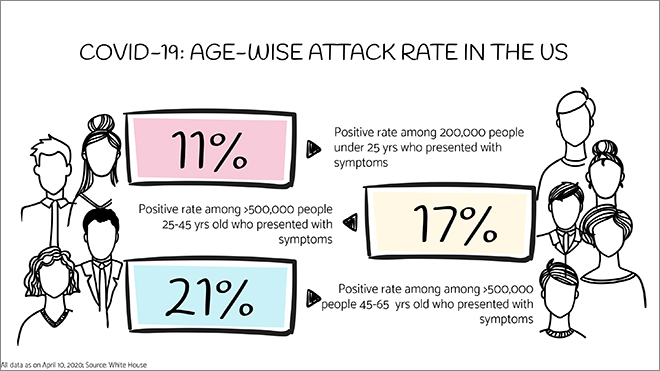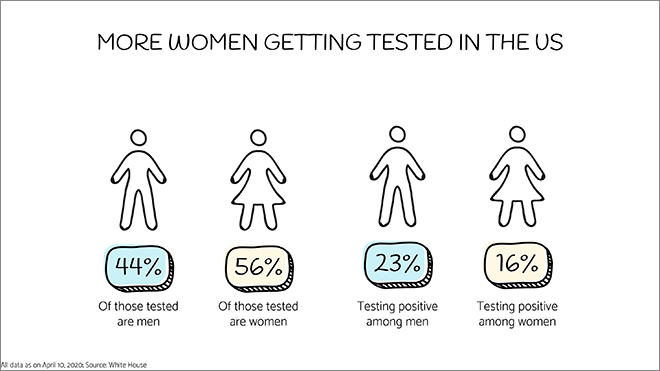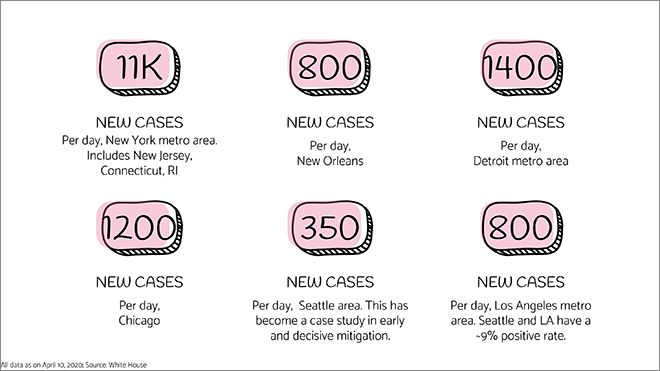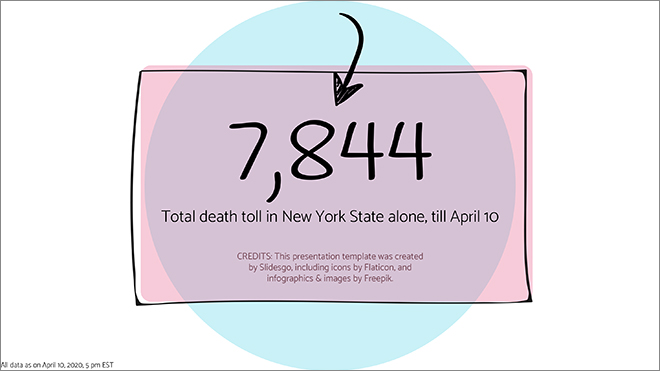
The White House believes that America’s incredibly steep coronavirus curve is finally levelling off, driven mainly by the New York metro area which accounted for more than half of the country’s 18,000 deaths by April 10. The week of April 6, 2020 has been the deadliest so far in New York - the epicenter of the US outbreak which has been reporting 50 per cent of all cases and 50 per cent of new cases.
New York has been stricken unlike any other US city. Ambulances wail down its streets, following a relentless, soul numbing route to the nearest hospital. In the of merely five days in its peak death week, more than 3,000 New Yorkers have died, taking the statewide total beyond 7,800, which is far more than the total toll from the 9/11 attacks. Yet, the faintest glimmer emerged of the curve finally flattening and it came from the slowing number of new cases, the single most urgent metric of this apocalyptic moment. New hospitalizations increased at a daily rate of well below 300 this week compared with daily increases of more than 1,000 last week and a crisis high of 1,427 new patients on April 2. The number of intensive care patients went down for the first time since mid-March.
New York’s saddest week from the coronavirus outbreak showed all of us that the window for decisive government action when a crisis hits is incredibly small. After that moment passed, the feverish scramble for medical supplies, like in New York, did not really help during the most painful phase. What is also clear is that social distancing and behaviour change is how this battle is won. It doesn’t come from one hot spot or densely populated urban areas alone. It comes with one mighty heave, when rural and urban areas come together, states learn from each other and replicate best practices. The White House is now taking heart from the mitigation lessons offered by three states out west — California, Washington and Oregon — which have all kept their virus curve from ever becoming logarithmic. This dispatch from the epicenter of the US outbreak brings you key takeaways from America’s darkest week.
Real time data trump the best predictive models
Models are as good as the assumptions they are based on, America’s top infectious diseases doctor Anthony Fauci never tires of telling us. Barely a week ago, the predictive model most frequently quoted by the White House pointed to a dire death toll of 100,000-200,000 with full social distancing in place. By April 10, the same model revised projections downwards to around 60,000 by early August this year based on the real world effects of behaviour change within society. The playbook is changing based on compliance with social distancing. We now know that the infection curves of cities outside of the New York metro area are much flatter and the rates at which their caseload is doubling is slower than in New York.
This isn’t the time to pull back from social distancing
Dr Fauci is confident America is headed in the “right direction.” “That means that what we are doing is working, and therefore we need to continue to do it. I know I sound like a broken record, that’s good — I want to sound like a broken record, let's just keep doing it”. Fauci is cautioning against declaring victory too soon because that, he says, will lead to multiple spikes. Containment strategies of contract tracing and testing at scale are the gold standard Fauci wants in place before America loosens social distancing guidelines.
11 percent of symptomatic people under 25 years testing positive
Data available for the first time in the US show 11 out of 100 people under the age of 25, 17 per cent in the 25 to 45 age group and 21 per cent of those between 45 and 65 years who presented with symptoms have tested positive for coronavirus. In the 65-85 age group, 22 percent of tests came back positive and a slightly higher 24 per cent positivity level in the over 85 years cohort. Data on those under 25 years were drawn from a universe of 200,000 tests while more than half a million people in the 25-45 years age group and in the 45-65 age group have been tested. Granular level data are showing that the elderly and those with comorbidities have worse outcomes.
More women than men getting tests done
Nearly 6 in 10 people who have been tested in the US are female while a little more than 4 in 10 are men. Positivity rates are 16 per cent for women and 23 per cent for men. Leaders of the White House coronavirus task force are urging American men to turn up and get tested, no matter what age group. Men often don't present in the healthcare delivery system until they have greater symptomatology, according White House coronavirus task force coordinator Dr. Deborah Birx.
Lower caseloads in new outbreak areas
Daily caseloads in new outbreak areas are lower than in New York. The New York metro area which includes northern New Jersey, Connecticut and Rhode Island is still seeing 11,000 new cases per day as on April 10, and positive tests are in the 40 per cent range. The New Orleans metro area is reporting 800 new cases per day, Detroit Metro Area 1400 cases per day, Chicago 1200 cases per day, Boston 1100 cases per day and Philadelphia metro area 1400 cases per day. In stark contrast, Seattle has 350 cases per day and the Los Angeles metro area 800 cases per day with test positive rates in the 9 per cent range. So, what did the West Coast do right that New York did not? The data has just begun whispering its secrets.
Therapeutics by year end?
There’s an “awful lot” that is going on with therapeutics trials at the National Institutes of Health, America’s premier medical research institution. By Fall or winter, could we pop a pill for COVID-19? Fauci is almost ready to commit to a yes.




The views expressed above belong to the author(s). ORF research and analyses now available on Telegram! Click here to access our curated content — blogs, longforms and interviews.








 PREV
PREV


